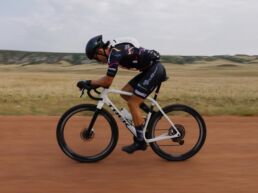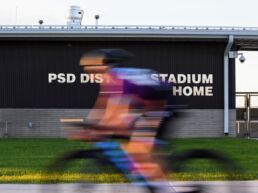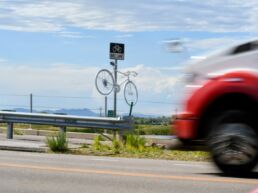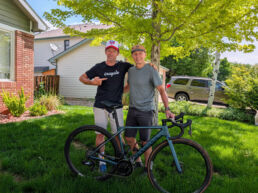 Scott Ellis racing Leadville just hours before his heart attack. The following article was written by world renowned endurance coach Gale Bernhardt of Loveland. Gale wrote this very important piece after local racer and close friend Scott Ellis died of a heart attack while racing the Leadville 100 last summer. It is possible and even likely that this article will save the life of an athlete that believes they are safe from heart disease because they eat right and exercise.
Scott Ellis racing Leadville just hours before his heart attack. The following article was written by world renowned endurance coach Gale Bernhardt of Loveland. Gale wrote this very important piece after local racer and close friend Scott Ellis died of a heart attack while racing the Leadville 100 last summer. It is possible and even likely that this article will save the life of an athlete that believes they are safe from heart disease because they eat right and exercise.
Article originally ran on http://galebernhardt.com/
I encourage you to read the full story for three key reasons:
– You are dead wrong if you think exercise and eating a “healthy diet” makes you immune from heart disease.
– There are heart disease screening tests that you probably don’t know about.
– There are subtle warning signs for heart disease that mimic common training and racing symptoms experienced by endurance athletes.
~~~~~~~~~~~~~~~~~~~~~~~~~~~~~~~~~~~~~~~~~~~~~~~~~~~~~~~~~~~~~~~~~~~~~~~~~~~~
On August 15, 2015 Scott Ellis was riding in his 19th Leadville 100 Mountain Bike Race in the Colorado mountains. After 8 hours and 25 minutes, 80 miles of racing and pushing his bike up the exposed mountain face known as the Powerline climb, he stopped for a few moments beside the trail. One of his teammates saw him stopped and asked if he was okay. Scott said he was okay and that he just needed to recover.
The teammate offered him some food, a chocolate gel. Scott asked if he had anything else. The teammate offered chews – that would work. His teammate then asked if Scott would consider walking with him? They could move ahead together at a slower pace in the heat. Scott replied, “No, you go ahead. I just need to rest a bit.”
The entire exchange took less than two minutes. The teammate started moving again and eventually, so did Scott.
Scott pressed on, riding the five false summits, until he was at the peak of the entire Powerline climb, at just over 82 miles of racing and roughly 11,000 feet. Before completing the descent of what racers call Sugarloaf down to Haggerman Pass Road, Scott stopped again – for the last time.
When he collapsed, a dozen fellow racers gathered to help him. They were all skilled in CPR, some at advanced life support, including two doctors, one of which is an emergency medicine doctor, two Emergency Medical Technicians (EMTs) as well as a fire fighter, and a pastor. Scott had the best care possible, under the circumstances. After 20 minutes of CPR, race EMTs came to the scene with a defibrillator and oxygen. The Flight for Life helicopter was called in and they aimed to take him to Saint Anthony’s Hospital in Denver. He died before the chopper was able to fly beyond Leadville.
Scott’s official cause of death was, “cardiac arrest due to significant atherosclerosis.” His plaque was also calcified. Those who knew Scott would have never anticipated this, extensive heart disease. He was 55. Too young to have heart disease, isn’t it? And he was fit, wasn’t he? How could he have heart disease? He exercised regularly, felt good about his health, tried to eat right, and saw his doctor on a regular basis. But, Scott did have heart disease and was taken by sudden cardiac death. How could this be?
Heart disease the number one killer, it is also a “Silent Killer”
First, let’s get some definitions clear. It is important to know that a heart attack occurs when blood flow to a portion of the heart is blocked (it is a mechanical, or circulation problem.) A heart attack can lead to sudden cardiac arrest (an electrical problem.) Sudden cardiac arrest (SCA) is defined as sudden, unexpected loss of heart function, usually caused by an electrical disturbance in the heart. With proper first responder care, people can survive a heart attack and SCA. A heart attack or SCA can lead to sudden cardiac death (SCD). Definitions vary, but most agree that SCD is defined as an unexpected death due to cardiac causes, generally occurring within one hour of symptom onset.
The 2015 American Heart Association report noted that heart disease is the number one global cause of death, currently estimated at 17.3 million annually. This number is expected to rise to more than 23.6 million by 2030.
Dr. Patrick Allen, a well-known forensic pathologist, adds a sobering fact: sudden cardiac death is the first presenting symptom of heart disease in 50% of those suffering a heart attack or SCA.
In athletes in particular, Dr. Neilly Buckalew a physiatrist, notes that heart disease is the most common cause of SCD starting as young as 35 years and the risk increases with age. The classic warning symptoms of heart disease or an oncoming heart attack may be completely absent or not easily discerned, and may be even more difficult to parse out in an athlete – even for a trained health care professional. A silent killer indeed.
Women have a lower incidence of SCD, but roughly 67% of women, as compared to 50% of men, have no history of heart disease symptoms.
We can all practice prevention to try and reduce our risk of heart disease, but it is obviously impossible to apply preventative care to people where death is the first symptom. Are there any signs or markers for the “Silent Killer” to help us on the journey in reducing heart disease outcome risks?
A fit heart’s story: The trail with Scott
I’ve known Scott’s family for years. I went to grade school with his older brother, Greg. Scott’s mom, Marge, and my mom share the same first name and shared chaperoning duty for many grade school activities. In late 1998, Scott contacted me about coaching him for the Leadville 100 Mountain Bike Race. He had done the race twice and was interested in going faster. Could I help?
I started coaching him and encouraged him to keep his winter fitness. I periodized his training by including periods of stress and recovery. We used heart rate zones to determine training intensity and evaluate recovery. He would begin a weight training program, ride an indoor trainer during the week and when the weather permitted he would ride with the Sunday group that met at my house.
In 1999 he did improve his race time to a new personal best and he became a regular Sunday group rider. Though our structured coach-athlete relationship lasted only one year, we became good friends and I knew him well.
In 2005, he convinced me to do the Leadville 100 Mountain Bike Race because “You’re doing most of the long rides with me anyway. You’ve got the fitness to do it. It will be fun!” I entered the race that year. He was always trying to recruit people to do long rides and races with him. He loved riding his bike and being active. Like you, it made his body feel good to move and be outdoors.
At the 2014 race, Scott and I began together, which we had done nearly every year of racing. I had hoped to stay with him until the Columbine Mine climb that summits at 12,600 feet, but I quickly lost sight of him shortly after the start of the race. When I entered the Twin Lakes aid station for the first pass, I was told that Scott was three or four minutes ahead of me heading into the Columbine climb.
He always gained time on me climbing Columbine. As I climbed, it was so good to see him descending with a big smile on his face, and shouting my name as he passed by. By the time we went through Twin Lakes for the second time, he was around 11 minutes ahead of me. I settled into my own pace for the next 30 miles, pushing my bike up the steepest part of the Powerline climb. Each year I try to ride the five false summits that follow the hike-a-bike section of Powerline. This was always one of Scott’s race goals as well.
Once off the climb and down the Sugarloaf and Hagerman Pass descents it was pavement time. There is some descending on the pavement before the often cruel climb to the Carter mini-aid-station. This climb can be hot. About three-quarters of the way up the climb, I spotted Scott off of his bike and leaning over. I asked if he was okay.
“I’d be a lot better if I could vomit,” he commented, “I’ll be okay.”
Scott was not unlike the hundreds of other riders both of us had passed earlier during that 2014 race. People were off of their bikes and suffering from one or more of the following: muscle cramps, lightheadedness, nausea, vomiting, diarrhea, dehydration, bonking, headache or side ache. He, like many endurance athletes, struggled with nutrition and hydration, trying to find the right fueling and hydration strategy and prevent nausea. Nausea is common in long distance athletes and especially at high altitudes where digestion slows.
He was back on his bike quickly and riding with me. As we rode along, I kept asking how he was doing. I could tell by the tone of his voice that he found my constant inquiry annoying. Given a role reversal, I’d likely feel the same way. For this day, we decided to peel back the speed and finish the last hour or so of the race at an easier pace.
The finish line was littered with people suffering from the same symptoms as Scott. He was convinced he had yet to find the secret food formula that wouldn’t cause him stomach upset.
It wasn’t often that Scott complained of an upset stomach outside of an event. But, during a March 2015 ski trip to Crested Butte, his skiing buddies, Pete Graham and Doug Pearson, commented that Scott felt significantly nauseated. As they recall, Scott seemed fine during a full day of skiing. They checked into a hostel and got a tip on a bar that had cheap beers for happy hour. After everyone had a beer or two, they walked over to a Mexican restaurant for a couple of margaritas and dinner. After dinner they headed back to the hostel.
Hanging out and chatting in the common area after dinner, at about 8:00pm Doug and Pete noticed Scott was missing from the group. Pete went looking and found Scott laying on the bathroom floor. Scott said that he had been vomiting and he felt nauseated. He said he just needed some time to recover. Pete checked on him several times before Doug and Pete moved Scott upstairs to his bed with a waste can at his side. Scott seemed okay throughout the night and mostly normal the next day.
Crested Butte sits at an elevation of 9,373 feet and peaks at 12,162 feet above sea level, it is not uncommon for people to experience some lightheadedness and nausea associated with altitude. However, Scott had spent multiple days skiing at another high area, Copper Mountain, the same season and didn’t exhibit this kind of illness.
Because Scott tended to be a two-beer-guy, perhaps he thought that the beer and margarita combination was the cause of his nausea, or maybe some bad food, and didn’t think much of it. We can never know what he thought or the real cause of the nausea in either of the situations described.
Nausea can be a subtle symptom of heart disease. At altitude, the oxygen demand on the heart increases even in the well-trained athlete. In the atherosclerotic heart, the demand is even higher and can cause subtle signs such as nausea. You need to heed the “subtle” symptoms to be safe as nausea may be telling you something. In women in particular, subtle symptoms such as nausea may be the only warning of heart disease and even impending heart attack.
It is important for women to pay close attention to subtle symptoms, particularly as they head towards peri-menopause and post-menopause where there is increased risk of heart disease.
Frank symptoms and signs in addition to nausea such as the sense of impending doom, sweating, shortness of breath (without exercise), feeling extremely tired, fullness or pain in the chest, back, shoulders, arm (either right or left), neck or throat are clear signs to get to the emergency room immediately.
Stress and influences that extend to the heart
As the 2015 ski season came to an end, it was time for Scott to focus on mountain bike racing. In the past couple of years, a group of us made it a spring tradition to go to Fruita, Colorado for three or four days of mountain bike riding. It was spring training camp.
While we were in Fruita, the days were long and sometimes the pace was fast. Scott seemed perfectly normal the entire trip. The only thing out of the ordinary is he skipped the last day of riding to get some work done. Scott was the Colorado Department of Transportation (CDOT) Resident Engineer for Region 4 and he had to review proposals from contractors that were bidding to repair the flood-damaged Highway 34. This project had been front-and-center on his plate since September 11, 2013 when historic flooding caused 14 Colorado counties to be declared a state of disaster emergency.
Scott was responsible for the Highway 34 emergency, temporary repairs that totaled $118 million. Repairs were completed, remarkably, by the first of December 2013. This extremely condensed timeline was stressful for everyone working on the project; everyone was proud and exhausted. But Scott’s workload had been at an unusually high level for over three years, due to special projects.
Though a complicated topic, many doctors I spoke with, including Dr. Peter Smith, an internal medicine specialist, and Dr. Buckalew said that chronic stress is an important factor contributing to heart disease. Possible mechanisms may be due to increased levels of cortisol and epinephrine. High and prolonged elevated levels of cortisol, the “stress hormone” can increase blood pressure and blood pressure is known to be the number one controllable risk factor for heart disease. High cortisol can also promote build up of plaques in the arteries.
There are many different types of stress and chronic work stress has been shown to increase risk for heart disease, in particular with demanding jobs where one feels they have little control or reward. Though chronic work stress was a part of Scott’s life, he wasn’t worried about his job stress because he was getting ready to retire from CDOT and take a well-deserved break. On Friday August 14, 2015, he spoke to CDOT managers and the plan was in place for Scott to retire at the end of 2015.
Acute stress is also linked to cardiac death, where the incidence of heart attacks and sudden death have been shown to increase significantly following the natural disasters like hurricanes, earthquakes and tsunamis or any event that provokes the “fight or flight response.”
We cannot always control the stressors in our lives, but we can control how we react to stress and try to decrease chronic stress. Dr. Buckalew points out that by regularly practicing deep breathing techniques and contemplative practices such as meditation can train our brain to not overly react to stressful situations, keeping our heart rate and blood pressure down.
Monitoring your blood pressure and heart rate are important. High blood pressure is an important independent risk factor for heart disease, as is persistent elevated resting heart rate. Heart rate response during training and racing activities can also give you more information about the status of your body. It is best to keep a journal for your heart rate and your training responses so you don’t have to rely on an unreliable memory.
Fatigue a symptom for heart disease … but what kind of fatigue?
Another subtle symptom of heart disease is fatigue. The reason you feel so tired is that your body is struggling to supply oxygen to all body parts. The body prioritizes and sends oxygen to critical parts like the heart and brain. The fatigue isn’t the occasional missed-a-night-of-sleep tired, but a chronic low-level of fatigue, not resolved by increased sleep or rest.
Many endurance athletes experience low-level fatigue when training for and competing in races. Scott would occasionally say he was tired, but we were all tired during high training loads. Additionally, many of the people that compete in endurance races are also high-performing professionals with a good load of stress that can cause fatigue, like Scott.
Take a hard look at the various sources of your fatigue.
The Conundrum: Physical activity protects us from heart disease but can increase risk of sudden cardiac death in the athlete with heart disease
One thing that is clear and uncontested, physical inactivity is a cause of cardiovascular disease. Those of us that enjoy endurance sport may feel smugly protected from heart disease due to “eating right,” our level of fitness and good health markers like blood pressure, triglycerides, and basic lipid profile numbers. Maybe this is how you feel?
The fact is, we should not be so smug and naive. Physical activity has both beneficial and adverse effects on SCD risk. Moderate regular physical activity can lower your risk of heart disease, but vigorous physical activity, particularly in men, can transiently increase risk for SCD in the person with heart disease. Regular vigorous exercise does reduce the increased risk of SCD, however the risk remains elevated even in the most habitually active men.
Dr. Allen notes that we also see increases in SCD for sudden vigorous increases in activity, such as snow shoveling after a big storm, for all types of people with heart disease. SCD during physical exertion is certainly not limited to fit athletes.
Is the answer to never exert yourself? The simple answer is no. You need to be fit and you need to monitor your health status with better tools than you have been using.
Athletic performance decreases, another sign?
In late May, several of us went to the western slope and rode in the Gunnison Half-Growler mountain bike race. It is a decently long race with tough climbs and descents. Scott used this race as a training event, not expecting to be in peak condition. He had a good race, considering his level of endurance fitness. The results were exactly what he expected, slower than some of his buddies.
June marked the beginning of his more serious training for Leadville. He made an effort to begin bike commuting to work and he planned to participate in a week-long bicycle tour, as he had done for the previous 18 years. One of the friends he rode with during the tour said that Scott seemed slightly slower than past years; but that was to be expected given his decreased endurance training and higher job load the last three years.
Scott’s performance decreases could certainly be related to lower levels of training. Or, was it due to heart disease?
With significant heart disease, lower levels of performance may or may not be present. For example, a 57-year-old man collapsed and died within one minute after setting a regional master’s record for the indoor 3000-meter run. A 42-year-old man ran a speedy 3:06 marathon just three weeks before an autopsy showed he had complete occlusion of one major coronary artery and 75-percent narrowing of the other two arteries, due to atherosclerosis.
If your fitness has been decreasing subtly and steadily for a period of time, this could be another sign of trouble; but don’t bank on performance decreases with heart disease.
Feeling lightheaded, another sign?
In the four months leading up to the 2015 Leadville race, Scott’s wife Connie recalled three incidents when Scott got up to get a snack in the evening and he was lightheaded. He steadied himself with a hand on the wall and once settled, he went about exploring the refrigerator and cupboards. Endurance athletes may feel lightheaded due to dehydration and electrolyte imbalances caused by training. Still others boast low blood pressure numbers and a quick move from a prone position can cause the head to spin.
Feeling dizzy or lightheaded, is a symptom caused by heart disease, but this feeling has many non-heart related causes and even for a trained health care provider this nonspecific complaint can be difficult to link to a cause. Dr. Tim Ferrell, a physiatrist and fellow Leadville 100 Mountain Bike Racer, who was one of the first responders to help Scott, noted that it is not unusual for endurance athletes to feel lightheaded due to increased training loads and reduced food intake during the weeks leading into a big race.
Dr. Ferrell himself has felt lightheaded but he and his wife, Dr. Buckalew, carefully monitor things like morning resting heart rate and pay attention to their overall health status.
2015 Leadville MTB 100 race day
Leadville 100 Mountain Bike Race morning began mostly normal. For the first time in 11 starts, I was in a corral ahead of Scott because I had a good performance in a qualifier race. He decided not to do the qualifier and instead did a bike tour. Pre-race, he found me in my corral, gave me a big good luck hug and told me, “I’m coming for you, I can see a target on your back.”
I laughed and told him that I expected to see him pass me on the Columbine Mine climb. I would try to hold on to his wheel for the remainder of the race. During the race, I did see him on the Columbine climb. I had begun the descent and he was still climbing, roughly 11 minutes behind me and with that big smile on his face.
I would never see him again.
Why can’t we better detect heart disease?
There are better tests available to detect heart disease. The controversies lie in which tests should be recommended and at what age. Let’s look at some of those tests.
Vertical Auto Profile (VAP) and Nuclear Magnetic Resonance (NMR) lipid profile tests are better
Scott had visited his personal physician not more than a month prior to the 2015 Leadville 100 Mountain Bike Race. He was happy because his basic lipid profile showed HDL cholesterol (high density lipoproteins, the “good ones”) was at a personal best. Scott reported that his overall test results were good and he had a stamp of approval.
Unfortunately, the current standard lipid profile test that measures our total cholesterol, and our low density lipoproteins (LDL, the “bad ones”) is technically limited as most labs do not directly measure LDL but calculate the value. Additionally, the standard method does not measure subclasses of HDL and LDL. Research has shown that LDL subclasses maybe key determinants of heart disease risk – better predictors than total cholesterol numbers.
According to Dr. Smith, the traditional test only reveals 40 percent of the people at risk for heart disease. That means 60 percent of people with heart disease do not get identified by this simple, inexpensive test. Dr. Smith suggests that it is better to use a blood profile test that directly measures LDL subclasses. Two such tests include the VAP and the NMR . Though slightly more expensive at around $100, the VAP and NMR tests can tell you much more than a $25 standard lipid profile.
The detailed tests categorize LDL and HDL cholesterol by relative size and measure blood lipids ignored by the standard traditional test such as very low density lipoprotein (VLDL); intermediate-density lipoprotein (IDL); and lipoprotein(a) [Lp(a)]. Apolipoprotein B100 (apoB100) can be also calculated and may represent the total number of atherogenic particles (those that tend to promote the formation of fatty plaques in the arteries), hence provides a better estimated risk for heart disease.
According to Dr. Smith, the good news that can be delivered in a detailed lipid profile is people showing high values in HDL subclasses HDL2 and HDL3 are better protected from heart disease risk because these components act like artery-unclogging Drano®.
The American College of Cardiology, American Diabetes Association, American Association of Clinical Chemistry, National Lipid Association, and American Association of Clinical Endocrinologists advise treating to LDL subclass targets, to optimize management of moderate and high risk individuals. However, this is not yet common practice and health insurance companies do not always cover detailed lipid profiling tests; but, this is changing and public pressure is key to this change.
The U.S. Preventive Services Task Force (USPSTF) has issued a set of general recommendations for the screening lipid disorders. For men, the USPSTF strongly recommends detailed lipid screening for men 35 years and older, regardless of heart disease risk, and recommends screening men 20 to 35 years of age for lipid disorders if they are at increased risk of heart disease (such as family history, high blood pressure, smoking, etc). Likewise for women, the USPSTF recommends detailed screening for women 45 years and older and screening women 20 to 45 years of age if they are at increased risk of heart disease.
In addition to the detailed lipid tests, several doctors recommend getting C-Reactive Protein (CRP) tested at the same time. This blood marker looks for inflammation and research has linked high levels of CRP to heart disease.
Cardiac Computed Tomography (CT)
Cardiac CT is a heart imaging test that uses CT technology with or without intravenous contrast dye to visualize the heart anatomy, coronary circulation, and the great vessels (the aorta, pulmonary veins, and arteries). There are several types of CT scans used in the diagnosis of heart disease, including: CT coronary artery calcium score (CACS), coronary CT angiography (CTA), and total body CT scan.
Of the three the CACS, often called a CT calcium scan, is a promising tool in providing additional information. The CACS measures the amount and pattern of calcium (also called hard plaque) that has accumulated in a patient’s coronary arteries. It is a visual indicator of clogged arteries.
Dr. Roger Ashmore, a cardiologist, noted that the American Heart Association recommends the CT calcium scan to further assess cardiac risk in symptomatic patients that are felt to be at intermediate risk of developing cardiovascular disease, in order to reclassify them into higher or lower risk status. The amount of coronary calcium has been recognized as a powerful independent predictor of future heart problems. Unfortunately, most insurances and Medicare do not cover this test even though it is relatively inexpensive at $100 to $300.
Some people would like to see this scan done on everyone at a certain age, similar to a colonoscopy or mammogram. There is controversy about this sweeping recommendation, including increased exposure to radiation. Whether this level of radiation is cause for concern or not is also controversial. Of course, adding more preventive screening increases health care costs and is another subject of disagreement.
If it were used, a CT calcium scan would have clearly shown Scott’s heart disease issues.
One con about the CT calcium scan is that it cannot detect the amount of soft plaque accumulated in the coronary arteries.
Carotid Intima-Media Thickness Testing (CIMT)
Carotid Intima-Media Thickness Testing (CIMT) uses ultrasound (usually externally applied) to measure the thickness of the inner most two layers of the carotid artery. It is a safe, noninvasive test. Increased CIMT thickness is associated with atherosclerotic disease and increased cardiovascular events. Even in patients who have no clinically apparent atherosclerosis and a CACS of zero may find atherosclerotic disease using CIMT. Despite its ability to detect early disease and power as a screening tool, in even asymptomatic patients, the AHA and American College of Cardiology only recommend this test in symptomatic patients with intermediate risk. This test is also relatively inexpensive running between $80 to $250.
All this talk about risk factors, does it apply to you?
It should be noted, risk includes family history. So what does family history mean? Dr. Buckalew points out most people do not have a detailed family history, or much of a history at all, and will not think much of just one family member dying young of heart disease (before 55 in men, before 65 in women). But this is an important risk factor, and even knowing things like a relative died in a car accident, but no one knows why is important. It begs the question, did they have a heart attack?
Now you know it is important to discuss all the possible risk factors with your health care provider. In addition to family history, chronic stress, and physical inactivity, some of the commonly listed heart disease risks are: age, being male and post-menopausal women, depression, “poor diet” (though what this really means in endurance athletes is unknown, but keep in mind a diet high in sugar is a risk factor), high blood pressure, diabetes, obesity, and poor dental health.
Only 3% of men and 4% of women reach the age of 50 without any risk factors for heart disease. Scott was 55 with risk factors, starting with his age, and subtle symptoms.
In short, the majority of us have risk factors so yes, this applies to you.
Being “fit” doesn’t mean you are off the hook
Just because you can complete acts that require some amount of physical fitness, does not necessarily mean you are healthy. For athletes, it is difficult to separate subtle heart disease symptoms from normal training and racing symptoms. In 11 years of racing the Leadville 100 Mountain Bike Race, out of all of the people that I’ve seen off the bike and suffering one or more of the subtle symptoms listed, only one has suffered a fatal heart attack, anecdotally confirming the evidence that the transient increased risk of SCD with vigorous physical activity is overall quite low.
Rather than being one of the statistics where your first sign of trouble is death, dispense the myth that heart disease is only found in the elderly, unfit, overweight people or those that smoke. Take your own health very seriously and carefully monitor health status and markers such as resting and exercise heart rate. Actively engage stress reduction techniques and seek health care if you have any concerns at all. Work with your health care providers to determine the best course of action for you, even if it means some low out-of-pocket expense.
At minimum, seriously consider getting the more advanced and accurate lipid profile test and possibly seek out further testing. Take ultimate responsibility for your health and be your own health advocate for as long as you can.
Gale Bernhardt is a two-time Olympic coach and fitness expert. An author of seven books and frequent author of health and wellness columns, she is recognized by Men’s Fitness magazine as one of the top online trainers.
*** A special note of thanks to all of the doctors that contributed to this column. All of them showed patience in answering what likely seemed to be endless questions. Dr. Neilly Buckalew and Dr. Patrick Allen were particularly helpful in providing content editing.
One last word about Public Health and SCD:
Automatic External Defibrillators (AEDs) save lives
With respect to public health, a critical tool for acute coronary events once they do happen are automatic external defibrillators (AEDs). AED’s save lives. According to the American Heart Association, in the US annually approximately 359,400 Emergency Medical Services (EMS)-assessed cardiac arrests occur outside of a hospital setting. On average, less than 10% of victims survive. As of 2013 it was estimated that 23% of out-of-hospital cardiac arrests are “shockable” arrhythmias, meaning the heart was in a rhythm that would respond to a shock from an AED.
Seconds count in the event of a heart attack and stopping a shockable rhythm. AED’s are designed for non-medical people to use without any training. Of note, communities with comprehensive AED programs that include CPR and AED training for rescuers have achieved survival rates of nearly 40% for cardiac arrest victims. Research has shown that an AED even in the hands of a lay-person still can help increase survival.
*** This article is not a complete discussion on heart disease risk and prevention nor is it to substitute the opinion of your health care provider.
Medical References:
A full list of references is available upon request. Physician references included below.
Allen, Patrick, MD (Forensic and Anatomical Pathlogist), former Larimer County Coroner, Loveland, CO.
Ashmore, Roger, MD (Interventional Cardiology, Cardiology, Cardiovascular Disease), UC Health, University of Colorado Health, Loveland, CO.
Buckalew, Neilly, MS, MSL, ND, MD: Physiatrist, Naturopath, Integrative Medicine Rehabilitation Specialist, National Institute of Health/National Institute of Aging Fellowship trained and published Mind-Body researcher, currently the Assistant Medical Director of the Rehabilitation Hospital of the Northwest, Program and Research Director of Living Oak Integrated Medicine and Rehabilitation, LLC, and the Founding Director of Yoga for Life in Post Falls, ID.
Ferrell, Tim, PT, MD, Physiatrist, Fellowship trained in Pediatric Physiatry, currently the Medical Director of the Rehabilitation Hospital of the Northwest, Post Falls, ID.
Smith, Peter, MD, FACP (Diabetes, Hypertension, Hyperlipidemia, Cancer screening, Clinical diagnosis, Research interests: Disease prevention) UC Health, University of Colorado Health, Loveland, CO.






